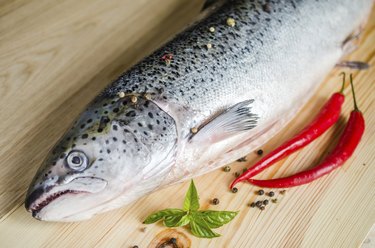
Whole salmon, either purchased from a fisherman or at the seafood counter or one you caught yourself, is a special treat. With it's rich-tasting, orange-colored flesh, salmon can be cooked via broiling, grilling, frying or poaching. However, it needs to be cleaned and prepared first, including filleting if you are planning to break down a whole salmon.
Choosing Fresh Salmon
Video of the Day
If you are purchasing fish from a fisherman or a fishmonger, look for signs of freshness to ensure you get a high-quality salmon. Look at the gills of the fish, checking that they are red and not brown. Fresh whole salmon should have clear, bright eyes. not cloudy ones. The skin should be shiny and elastic when touched or pushed down on, not mushy. Fresh salmon should not smell fishy at all.
Video of the Day
Scaling and Gutting Salmon
Wash the whole salmon in clean water, even if you purchased it from the supermarket. Scale the fish by scraping gently with a dull knife. Start at the tail and move toward the head, keeping the knife at a 45-degree angle. Do both sides and then rinse off the scales. To gut the fish, cut along the belly between the fins, starting from the tail to the bottom of the head. Use a thin, flexible knife to make this easier. Remove all of the innards and gills from the fish. Thoroughly rinse the inside of the fish to remove any blood.
Cutting, Deboning and Skinning
If you like, you may trim a whole salmon into fillets or steaks, as well as remove the skin. Fillet the salmon by cutting along the backbone and ribs, keeping the knife parallel to the table, removing as much meat as possible. To cut a salmon into steaks, make cuts perpendicular to the backbone at 1- to 1 1/2-inch intervals, cutting through the back and ribs. Remove the ribs from individual steaks by sliding a knife between the flesh and the rib-belly membrane, then cutting upward to remove the rib bone. To skin the salmon, lay the fillets skin-side down on a table and slice the skin off with the knife angled slightly. For large fillets, once a small portion has been loosened, you sometimes can just pull off the skin with your hands.
Storing Fresh Salmon
Rinse the salmon after dressing and filleting, and pat it dry with paper towels. Store fresh salmon in tight plastic wrap to minimize the amount of oxygen exposure. Keep wrapped salmon in the coldest part of the refrigerator — at least 32 degrees Fahrenheit. The warmer the temperature at which it is stored, the more quickly it spoils. Properly wrapped, raw salmon keeps for up to two days in the fridge. Frozen salmon wrapped in plastic wrap keeps for two to three months in a home freezer. If it is vacuum sealed, it can last for three to four months in a freezer or six to 12 months in a deep freezer.